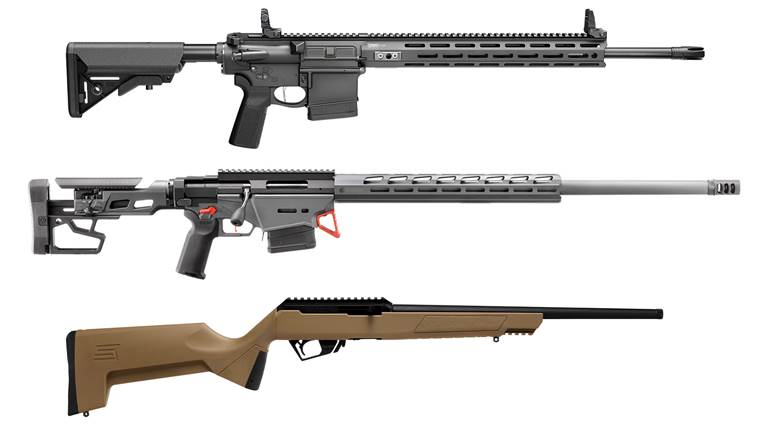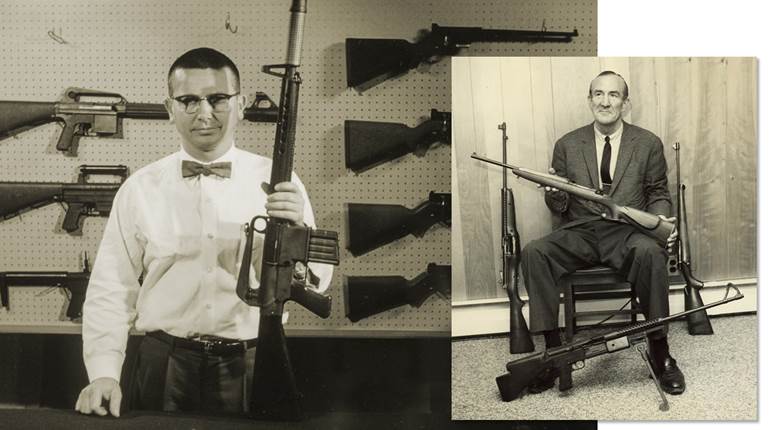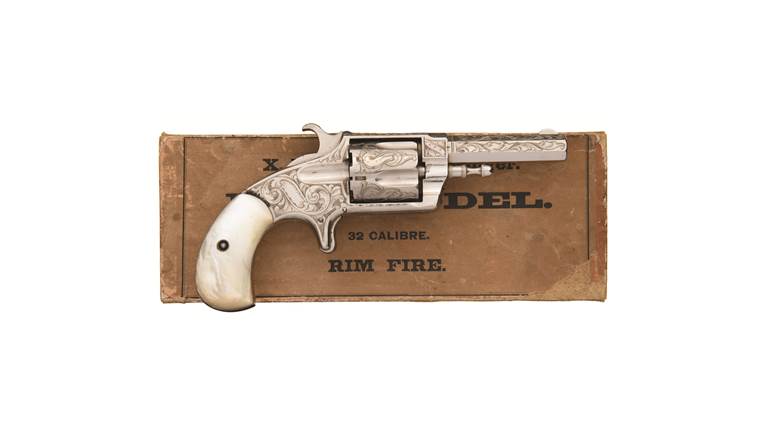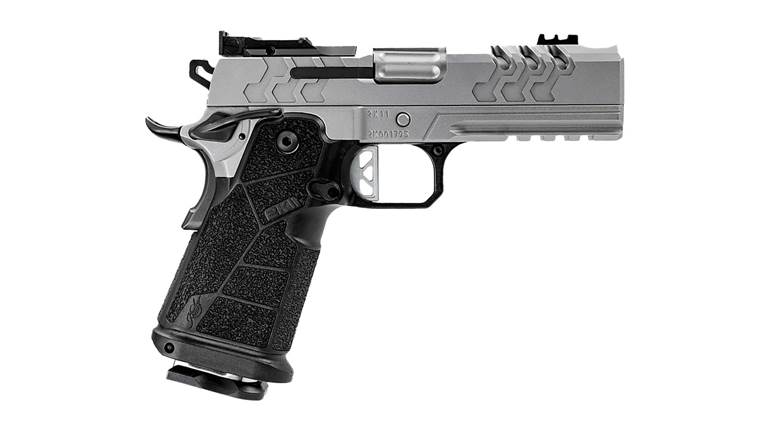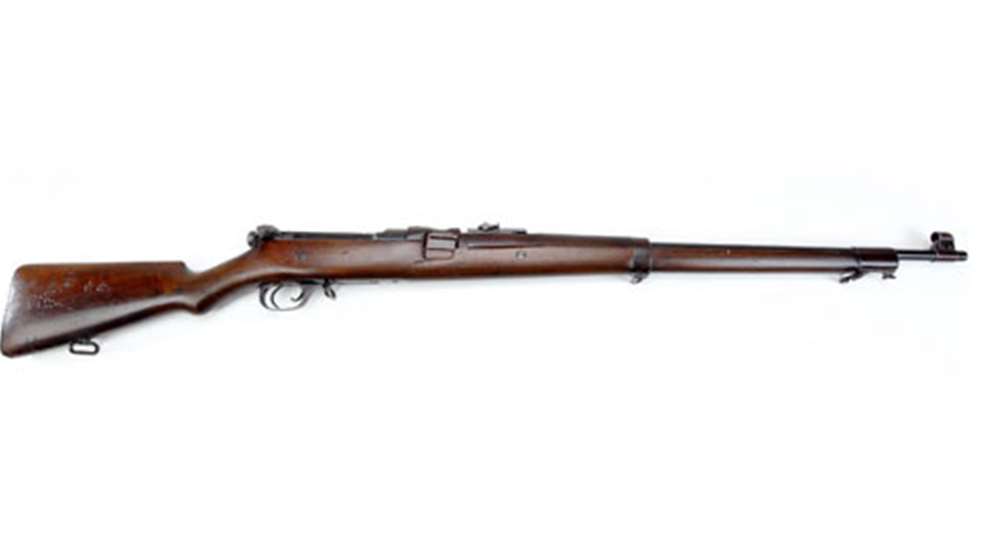
When the United States entered the Great War in the spring of 1917, our armed forces were ill-equipped for the conflict. All types of armaments were in short supply, especially service rifles. Production of the standardized Model 1903 Springfield was ramped up as quickly as possible, but the projected rate of manufacture would not be sufficient. To help alleviate the shortfall, the U.S. Model of 1917 rifle, a slightly modified version of the .303 British Pattern 1914 rifle, which had been manufactured under contract by three American firms, was adopted. Even with the M1917 and increased ’03 production, there remained a troubling shortage of rifles with which to train recruits and draftees flooding into camps across the country.
At times, recruits were issued broomsticks to practice close-order drill. Obsolescent .30-40 Krag rifles were called back into service, but additional arms were still needed. A number of Model 1891 Mosin-Nagant rifles, originally manufactured by Remington Arms and New England Westinghouse for the Russian government, were purchased. Even so, the Army still sought additional rifles for training use in the United States. In late 1917, another source became available when Mark II Ross .303 British rifles were deemed expendable by the Canadian military.
The Ross rifle was invented by Sir Charles Henry Augustus Fredrick Lockhart Ross, a Scottish nobleman, born in 1872. While still a student at Eton College, Ross received his first firearm patent in 1893. He subsequently refined the design and, in 1897, received another patent for an unusual straight-pull bolt-action rifle. The bolt was opened and locked by means of rotating locking lugs that operated in a manner somewhat similar to artillery pieces of the era. The straight “back-and-forth” manipulation of the bolt increased the rapidity of fire (at least in theory) as compared to the more conventional turning-bolt actions.
A limited number of Ross rifles was made in Great Britain, but the inventor soon decided to move his manufacturing operation to Canada where he had made numerous business and social contacts. Ross opened a manufacturing facility in Quebec City in 1903 and obtained a contract with the Canadian government for 12,000 Mark I rifles. The Ross rifle was touted as having several advantages over the Short, Magazine Lee-Enfield (SMLE), including lighter weight, a faster rate of fire and easier disassembly.
Sir Charles Ross also introduced the .280 Ross cartridge, one of the first commercial high-velocity sporting cartridges. While several variants of sporting and commercial rifles were made, the Canadian military was Ross’ most important customer. There were eventually three major variants of Ross military rifles: the Mark I; Mark II; and Mark III. And there were also a number of sub-variants of each type. In order to have commonality in ammunition with the SMLE rifle, the Ross military rifles were chambered for the standard .303 British cartridge. Eventually about 420,000 Ross service rifles were manufactured, of which the British government purchased 342,040.
The Ross rifle variant that saw the widest issue by the Canadian military was the Mark II. The gun weighed slightly less than 10 pounds and had a 30½- barrel with an overall length of 50¼ inches. While it aided in accuracy and increased muzzle velocity, the relatively long barrel resulted in a rather unwieldy arm in the tight confines of trench warfare.
The rifle was fitted with the “Harris Controlled Platform Magazine,” which was a lever on the right side just in front of the receiver that could be depressed to make loading easier. The barrel-mounted folding-leaf rear sight was similar to the German Mauser’s sight. The left side of the Mark II receiver was marked “Ross Rifle Co. Quebec, Canada 1905/Patented.” Most of the exterior metal components of the Ross rifles were blued, and the stocks and handguards were crafted from good-quality walnut. The front sight blade was protected by a removable metal cover.
The blade of the Ross rifle bayonet was somewhat unusual and has been described as having a “butcher knife” configuration. The bayonet’s unmarked blade was 101⁄8-inches long and about 11⁄8-inches wide. The pommel was marked “Ross Rifle Co./Quebec” with patent dates. The scabbard for the Ross bayonet was made of brown leather and had a reinforced throat. A leather belt loop was attached to the scabbard.
The Canadian 1st Infantry Division troops deployed to France in World War I with their Ross rifles in hand and were soon in the thick of combat. While Ross sporting rifles were impressive on the pre-war target ranges, problems quickly arose when the military variants began to see use in the muck and mire of the trenches on the Western Front during the First World War. The straight-pull bolt mechanism often became inoperable when exposed to even modest amounts of dirt and mud, which were omnipresent in the trenches.
Another serious flaw in the Ross was that the rifle’s bolt could be incorrectly assembled, which could permit it to fire without being securely locked. This situation could cause potentially disastrous results to the shooter. Due to these problems, it is reported that soon after the Battle of Ypres in 1914, some Canadian soldiers threw away their Ross rifles after they had hopelessly jammed. They were replaced with SMLE rifles obtained from dead and wounded British soldiers. One Canadian infantry officer is said to have commented that it could take five men to keep one Ross rifle in operation!
Initially, the Canadian military would not admit there was anything wrong, and the rifles continued to be issued to troops in France. But it eventually became crystal clear that the Ross was too badly flawed a military rifle to permit continued front-line use. It simply wasn’t up to the task. In July 1916, Sir Douglas Haig ordered that the Ross rifles be withdrawn from service and replaced by the British SMLE. Limited numbers of Mark IIs, fitted with American Model 1913 Warner & Swasey “Musket Sights” (prismatic rifle telescopes), continued to be used by some Canadian snipers. The superbly accurate Ross proved to be an excellent sniper rifle, because snipers, as compared to the average infantrymen, could keep their rifles relatively clean.
After withdrawal from front-line service, the Ross rifles were utilized by the Canadians and British for training purposes. After the United States entered the war, the Ross rifles in storage in Canada were viewed as a potential source of training rifles for our nation as well. The Canadian government was initially approached by the adjutant-general of the State of New York to see if some arrangements could be made to obtain sufficient numbers of the Ross rifles for training the New York State Guard troops (analogous to today’s National Guard) slated for eventual deployment overseas. Negotiations were soon taken over by representatives from the U.S. War Dept. as training rifles were also sorely needed by the rapidly expanding U.S. Army.
On Nov. 17, 1917, an agreement was reached for the purchase of 20,000 Mark II Ross rifles from the Canadian government, complete with bayonets, scabbards, slings and oil bottles for $12.50 each. A quantity of spare parts (at a cost of $7,814.78) and about 2,000 Ross rifle manuals were also procured along with 4,629,470 rounds of .303 British ammunition (at a cost of $20 per 1,000). About half the Ross rifles were acquired by the State of New York for “… defense purposes” (State Guard units). The remaining rifles were purchased by the U.S. Army and divided in equal numbers (5,000 each) between Camp Sherman, Ohio, and Camp Devens, Mass.
It is reported that many of the rifles issued to the Army subsequently had the original Ross slings replaced with M1917 Kerr slings. This web sling had recently been adopted for the M1903 and M1917 rifles to replace the standardized M1907 leather sling and was readily adaptable to the Ross as well.
The Ross rifle stocks were typically stamped on the right side (between the grip and the butt) with Canadian army unit markings. The serial number was applied to the bottom of the stock on the grip. The Mark II rifles subsequently procured by the U.S. Army were also stamped with an Ordnance Dept. “flaming bomb” and “U.S.” in the same location. It has been reported that at least some of the Ross rifles acquired by New York were stamped “NY” on the stocks. The Ross bayonets procured by the United States also had an Ordnance “flaming bomb” over “U.S.” stamped on the obverse grip. The same type of markings were applied to the leather scabbards as well.
After World War I, the American-owned Ross rifles were declared surplus, and some were sold via the Director of Civilian Marksmanship (DCM) to NRA members, initially for $5 each. There were few takers, and the price was later reduced to $3.50, but they still weren’t big sellers. By 1926, the remaining unsold Ross rifles were returned to storage until 1940, when they were repatriated to Canada under provisions similar to Lend-Lease. It is reported that many of these rifles were still in their World War I-era Canadian military packaging when they were returned.
While the Ross rifles did not see overseas combat duty in the hands of the American Doughboys (which was a good thing given their prior performance with the Canadians), the rifles did make available a number of badly needed M1903s and M1917s for combat units rather than training duty. While obviously a flawed combat rifle, it was entirely satisfactory for the limited role it played as a training rifle in the U.S. Army’s arsenal during the “Great War.” It is a rather sad legacy for a military rifle, though, when among the best things that can be said for it is, “Hey, it was better than a broomstick!”












